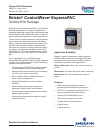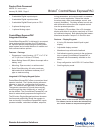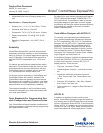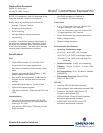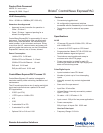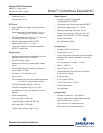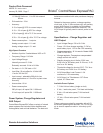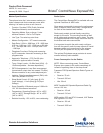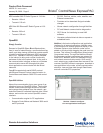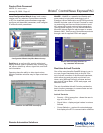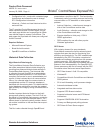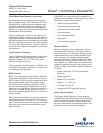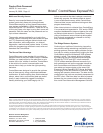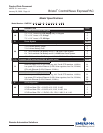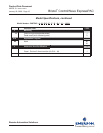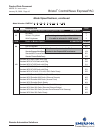
Product Data Document
420DS-7d / D301312X012
January 29, 2009 - Page 8
Bristol
®
ControlWave ExpressPAC
Remote Automation Solutions
Website: www.EmersonProcess.com/Remote
Modem Specications
The optional auto-dial / auto-answer modem pro-
vides a sleep mode that conserves power while
allowing it to wake up when a call comes in.
Function: Provides PSTN (Public Switched •
Telephone Network) communications
Operating Modes: Sync or Async. 2-wire •
switched network - Half or Full Duplex
Line Type: Two-wire loop start lines•
Modem Conguration: “AT” based commands•
Data Rate: V.32 bis - 9600 bps, V.32 - 9600 bps, •
V.22 bis - 2400 bps, V.22 - 1200 bps or 600 bps,
V.21 - 300 bps, Bell 103J - 300 bps, Bell 212A
- 1200 bps
Telephone Functions: Dialing and answering •
by AT commands. Automatic answering is also
programmable
Approvals: Telephone - FCC Part 68 (also •
suitable for approval within Canada)
Trans. Output Levels: -10 dBm xed (USA) - (0-•
15 dBm adjustable – rmware dependent)
PSTN Arrangements: Loop Start arrangement •
(transmission output does not exceed -10 dBm).
Allows connection to any voice telephone jack
Isolation: Data Access Arrangement (DAA) with •
1000 Vac (Modem to PSTN)
Sleep Mode Current: 0.5 mA (max) @ 12V •
(Input Voltage); 1.0 mA (Max) @ 6V (Input
Voltage)
Surge Capability: Withstand surge of 100A with •
10 x 160 microsecond waveform
Temperature: Operating Range: -40º to +60ºC •
(-40º to 140ºF); Storage Range: -40º to +85ºC
(-40º to 185ºF)
Relative Humidity: 15% to 90%, non-condensing•
Radio Option
The ControlWave ExpressPAC is available with one
optional FreeWave or MDS radio.
Since some users prefer to procure the radios sepa-
rately, Emerson offers “radio-ready” congurations
for each of the standard radio models.
Radio-ready models include literally everything
except for the radio. The mounting bracket as well
as all cables and connections are in place. The user
or integrator/installer must simply mount the radio to
the bracket and make connections.
It is important to match the radio-ready congura-
tion with the specic radio the user expects to install
because cables and connections for the antenna,
RS 232 port and power all vary by radio model.
The optional Polyphaser surge protector is recom-
mended with any radio selected.
Power Consumption for the Radios
NOTE: When conserving power, ControlWave
Express turns power to the radios completely off
instead of operating them in the sleep mode.
Freewave FGR Spread Spectrum Radio Figures at
12 Vdc:
Receive: 75 mA•
Transmit: 500 mA•
Idle: 20 mA•
MDS TransNet 900 Spreabd Spectrum Radio Fig-
ures at 13.8 Vdc:
Receive: 115 mA•
Transmit: 510 mA•
MDS models 4710 and 9710 Licensed, UHF Radios
with gures at 13.8 Vdc:
Receive: 125 mA•
Transmit: 2000 mA•



